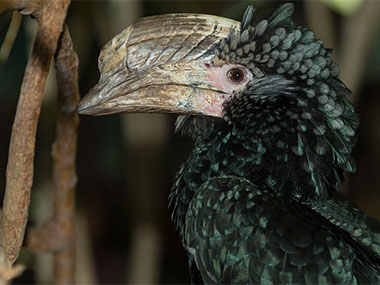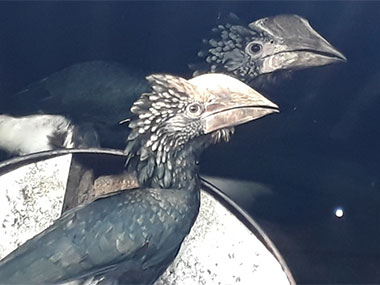



The Silvery-cheeked Hornbill forms part of the Bycanistes family of African Hornbills. A group consisting of fairly large, mostly black hornbills with some white plumage, largely concentrated in the wing and tail feathers. A very distinctive feature of this group is their very large casques situated on the top mandible.
Silvery-cheeked Hornbills are fairly large birds measuring around 75cm. They are predominantly iridescent black. The belly, back and outer-tail tips are white as well as the underwing coverts which is only visible in flight, a feature that distinguishes them from other members of the group which carry white feathers in the wings. They sport a huge creamy casque, much reduced in hens and juveniles. The adult birds have silvery tips on the cheek feathers giving rise to the name of the bird.
Sexing is very easy with these large birds. Cocks carry a very large and elongated casque in comparison to that of the hen which is a lot more reduced.
The Silvery-cheeked Hornbill is native to the eastern parts of Africa, starting in Ethiopia then downwards through Kenya, Tanzania, Malawi, Zimbabwe and Mozambique. It’s a fairly common resident inhabiting Montane and Coastal forest up to 2600m above sea level. In the dry season when food are scarce they tend to be nomadic within their range. In Zimbabwe the birds are threatened due to habitat destruction. There has been limited imports over the years, those that have been imported are most probably from Tanzanian wild caught stock. Our birds was purchased from the now defunct Bester birds and animals around 2014/2015.
Silvery-cheeked Hornbills are omnivorous. The natural diet consists mainly of fruits, notably figs, and also flowers. They are very opportunistic and will take small animals and lizards when the opportunity presents itself. They also raid bird nests and will take eggs and chicks without hesitation.
For our birds we provide fresh food twice daily. Our diet consists of a variety of fruits, the staple being pawpaw, apples, pears and bananas which are available year round. Seasonal fruits are offered when in season. We also offer them a good quality dog pellet with a very low salt content that we soak in hot water. We also supply pinkies (baby mice) and super worms daily.
In the wild they live in pairs and occasionally they do roost in fairly large flocks of several dozen individuals. They have a straight and undulating flight. They glide after every 4 or 5 noisy wing beats. As would be suspected with these large birds, most would supply fairly large accommodation for such birds. However our aviary is quite moderate in size in comparison to other breeders. The pair is housed on their own in an aviary measuring 4 meters long by 2 meters wide by 2 meters high. It is an all wire enclosure including the roof with only the back section under cover where the nest is situated.
Courtship behaviour, when witnessed is very simple with the cock simply hopping back and forth over the hen. They typically breed in a tree cavity, usually in the spring. Clutch size can vary from 1 – 3 eggs with incubation at about 40 days. The female will be sealed in with the eggs and chicks making use of mud as the sealant only leaving a slit for the purpose of feeding. She is cared for by the cock during this entire process. Juveniles usually stay with the parents just short of 3 months.
Our birds were supplied with a 210 litre steel drum that we usually supply for our Macaws. This was their first attempt at breeding. We’ve had them around 4/5 years and at the time of import - after a routine vet check with the late Dr Chris Kingsley - he concluded that they were around 3 years old, so that puts them at around 7 years of age. Only one egg was laid and as soon as it was expected to have hatched the twice daily food supply was increased to 4 times a day with a big emphasis on the livefood. The hen subsequently broke the nest open in due course with her and the lone chick emerging on the same day with a lot of noise emitted by both parents. This has been recorded with my club, the Rand Avicultural Society as the first recorded breeding for the club in its 70 years of existence, and quite possibly a first recorded breeding in South Africa.
Having bred many species of birds of various genera over the years, the breeding of the Silvery-cheeked Hornbill has been a very special experience for me on a personal level, and I feel very blessed to have achieved this goal.